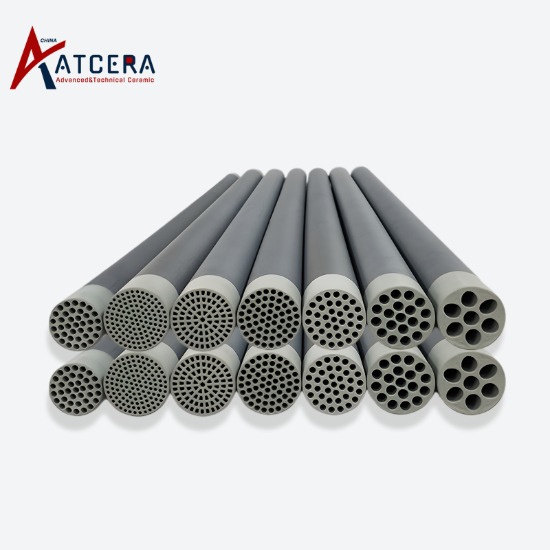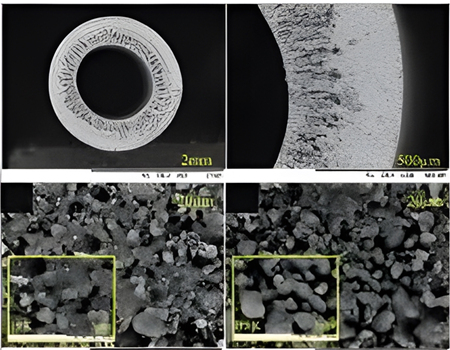ņĀüņÜ® Ļ│ĄņĀĢņØä ņ£äĒĢ£ Ļ│Āņä▒ļŖź ĒāäĒÖöĻĘ£ņåī ļ®żļĖīļĀłņØĖ ĒŖ£ļĖīļź╝ ņżĆļ╣äĒĢśļŖö ļ░®ļ▓ĢņØĆ Ēśäņ×¼ ņŚ░ĻĄ¼ ĒĢ½ņŖżĒī¤ņØ┤ ļÉśņŚłņŖĄļŗłļŗż. ņŗżļ”¼ņĮś ņ╣┤ļ░öņØ┤ļō£ ļ®żļĖīļĀłņØĖņØĆ ņØ╝ļ░śņĀüņ£╝ļĪ£ ņ¦Ćņ¦Ćņ▓┤, ņĀäņØ┤ņĖĄ ļ░Å ļČäļ”¼ņĖĄņ£╝ļĪ£ ĻĄ¼ņä▒ļÉ£ ļ╣äļīĆņ╣Ł ĻĄ¼ņĪ░ņ×ģļŗłļŗż. ņżĆļ╣ä Ļ│ĄņĀĢņŚÉļŖö ņŻ╝ļĪ£ ļ╣īļĀø ĒśĢņä▒(ņ¦Ćņ¦Ćņ▓┤ ĒśĢņä▒, ļ¦ē ĒśĢņä▒) ļ░Å ņåīĻ▓░ņØ┤ ĒżĒĢ©ļÉśļ®░, ļæś ļŗż ļ¦ē ĒśĢņä▒ ņä▒ļŖźņŚÉ Ēü░ ņśüĒ¢źņØä ļ»Ėņ╣®ļŗłļŗż. ņĀüņĀłĒĢ£ ņżĆļ╣ä Ļ│ĄņĀĢņØĆ ņäĖļØ╝ļ»╣ ļ®żļĖīļĀłņØĖņØś ļ¼┤Ļ▓░ņä▒ņØä Ē¢źņāüņŗ£ĒéżĻ│Ā ĻĘĀņŚ┤, Ēü░ ĻĄ¼ļ®Ź ļ░Å ĻĖ░ĒāĆ Ļ▓░ĒĢ©ņØä ļ░®ņ¦ĆĒĢĀ ņłś ņ׳ņŖĄļŗłļŗż. ļ®żļĖīļĀłņØĖ ņĖĄņØä ņ£äĒĢ£ 4Ļ░Ćņ¦Ć ņŻ╝ņÜö ņżĆļ╣ä ļ░®ļ▓ĢņØ┤ ņ׳ņŖĄļŗłļŗż:

ŌĆŗ
ļöź ĒÆĆļ¦ü ļ░®ļ▓Ģ
ļöź ņĢż ĒÆĆ(Dip and Pull) ļ░®ņŗØņØĆ ņŻ╝ļĪ£ ļŗżņØīĻ│╝ Ļ░ÖņØĆ Ļ│ĄņĀĢņØä ĒżĒĢ©ĒĢ£ļŗż. ņ▓½ņ¦Ė, ņäĖļØ╝ļ»╣ ņ×ģņ×Éļéś Ļ│ĀļČäņ×É ņĀäĻĄ¼ņ▓┤ļź╝ ļ¼╝ņØ┤ļéś ņ£ĀĻĖ░ņÜ®ļ¦żņŚÉ ļČäņé░ņŗ£ņ╝£ ĻĘĀņ¦łĒĢśĻ│Ā ņĢłņĀĢņĀüņØĖ ļ¦ē ņĀ£ņĪ░ņÜ®ņĢĪņØä ĒśĢņä▒ĒĢśĻ│Ā, ņĮöĒīģ Ēøä Ēæ£ļ®┤ņŚÉ ņŖĄņ£żļ¦ēņØä ĒśĢņä▒ņŗ£Ēé©ļŗż. ļŗżĻ│Ąņä▒ ņ¦Ćņ¦Ćņ▓┤. ņØ┤ ļ░®ļ▓ĢņØś ļ¦ē ĒśĢņä▒ ņøÉļ”¼ņŚÉļŖö "ļ¬©ņäĖĻ┤Ć ņŚ¼Ļ│╝"ņÖĆ "ļ¦ē ĒśĢņä▒"ņØ┤ ņ׳ņŖĄļŗłļŗż. ļ¬©ņäĖĻ┤Ć ņŚ¼Ļ│╝ļŖö Ļ▒┤ņĪ░ĒĢ£ ļŗżĻ│Ąņä▒ ņ¦Ćņ¦Ćņ▓┤Ļ░Ć ļ¦ē ņĀ£ņĪ░ ņÜ®ņĢĪĻ│╝ ņĀæņ┤ēĒĢĀ ļĢī ļ░£ņāØĒĢ®ļŗłļŗż. ļ¬©ņäĖĻ┤ĆļĀźņŚÉ ņØśĒĢ┤ ļČäņé░ļ¦żļŖö ņ¦Ćņ¦Ćņ▓┤ ņĢłņ£╝ļĪ£ ļōżņ¢┤Ļ░ĆĻ│Ā, ļ¦ē ņĀ£ņĪ░ņÜ®ņĢĪņØś ņ×ģņ×ÉļŖö ņ¦Ćņ¦Ćņ▓┤ Ēæ£ļ®┤ņŚÉ ļ©Ėļ¼╝ļ®┤ņä£ ļ¦ēņØä ĒśĢņä▒ĒĢśĻ▓ī ļÉ£ļŗż. ņ¦Ćņ¦Ćņ▓┤ņÖĆ ņĀ£ļ¦ēņÜ®ņĢĪņØ┤ ņĀæņ┤ē Ēøä ļČäļ”¼ļÉśļŖö Ļ│╝ņĀĢņŚÉņä£ ļ¦ēņØ┤ ĒśĢņä▒ļÉśĻ│Ā, ņĀ£ļ¦ēņÜ®ņĢĪņØĆ ņĀÉņä▒ļĀźņØś ņ×æņÜ®ņ£╝ļĪ£ ņ¦Ćņ¦Ćņ▓┤ Ēæ£ļ®┤ņŚÉ ļ©Ėļ¼╝ļ®┤ņä£ ļ¦ēņØä ĒśĢņä▒ĒĢśĻ▓ī ļÉ£ļŗż. ņżĆļ╣ä ļ░Å ņĄ£ņĀüĒÖö Ēøä ņäĖļØ╝ļ»╣ ļ®żļĖīļĀłņØĖ ĒŖ£ļĖīļŖö ļåÆņØĆ ļ░śļ│Ąņä▒ņØä Ļ░Ćņ¦Ćļ®░ ĒĢśņłś ņ▓śļ”¼ņŚÉ ĒāüņøöĒĢ£ ĒÜ©Ļ│╝ļź╝ ļéśĒāĆ ļāģļŗłļŗż . ļöź ņĢż ĒÆĆ(Dip and Pull) ļ░®ļ▓ĢņØĆ ņĪ░ņ×æņØ┤ Ļ░äļŗ©ĒĢśĻ│Ā ņŚÉļäłņ¦Ć ņåīļ╣äĻ░Ć ņĀüĻĖ░ ļĢīļ¼ĖņŚÉ Ļ░Ćņן ļäÉļ”¼ ņé¼ņÜ®ļÉśļŖö ļ¦ē ņĀ£ņĪ░ ļ░®ļ▓Ģ ņżæ ĒĢśļéśņ×ģļŗłļŗż.

ļöź ņĢż ĒÆĆ(Dip and Pull) ļ░®ņŗØņŚÉ ņØśĒĢ£ SiC ļ®żļĖīļĀłņØĖ ņĀ£ņĪ░ ļŗ©Ļ│ä ļŗżņØ┤ņ¢┤ĻĘĖļש
ļČäņé¼ļ░®ņŗØ
Spraying method is to use the spray gun to atomize the dispersed membrane making liquid into small droplets, and then deposit on the surface of the support body to form a membrane layer. The main operating parameters of the spraying method include the distance between the spray gun and the support body, the spraying pressure and the spraying time. Compared with dip and pull method, spraying method has the significant advantage of reducing the surface tension of the membrane making liquid through atomization, which is conducive to reducing the infiltration of the membrane layer into the support body pores, and thus reducing the interface resistance between the support body and the membrane layer. The spraying method has the advantages of easy large-scale production, simple operation, high slurry utilization efficiency and easy adjustment of membrane thickness. However, at present, this method is only used for the preparation of microfiltration membranes, and it does not meet the preparation requirements of small pore size membranes such as ultrafiltration and nanofiltration.

Spraying device diagram
Chemical Vapor Deposition Method
Chemical vapor deposition (CVD) is a method to prepare ceramic membrane by chemical reaction of one or several gaseous elements or compounds on the surface of porous support. The ceramic membrane prepared by this method has the characteristics of small membrane pore size and relatively low preparation temperature. However, CVD membrane has the disadvantages of harsh conditions, cumbersome process, high energy consumption and low membrane flux. At present, CVD membrane is mostly used in gas separation field, and its application in other fields needs to be further expanded. Chemical vapor deposition technology can only be used with chip ceramic membrane, and it is difficult to uniformly deposit in the preparation process of tubular or multi-channel ceramic membrane.

Schematic diagram of a CVD system for SiC membrane deposition
Phase Transformation Method
ņāüņĀäĒÖśņØ┤ļ×Ć ļŗżļ¤ēņØś ĒÅ┤ļ”¼ļ©Ė ņÜ®ņĢĪņØä ĒĢ©ņ£ĀĒĢ£ ņäĖļØ╝ļ»╣ ĒÄśņØ┤ņŖżĒŖĖĻ░Ć ņŖĄņŗØ ļśÉļŖö Ļ▒┤ņŗØ ņ£ĀļÅäņŚÉ ņØśĒĢ┤ ņĢĪņ▓┤ņŚÉņä£ Ļ│Āņ▓┤ļĪ£ ļ░öļĆö ņłś ņ׳ņØīņØä ņØśļ»ĖĒĢśĻ│Ā, ņŖĄņŗØ ļ░Å Ļ▒┤ņŗØņØĆ ĒÅ┤ļ”¼ļ©Ė ņÜ®ņĢĪņØ┤ ļ╣äņÜ®ļ¦ż ņØæņČĢņĪ░ ļśÉļŖö ļīĆĻĖ░ņŚÉ ļģĖņČ£ļÉ£ļŗżļŖö Ļ▓āņØä ņØśļ»ĖĒĢ®ļŗłļŗż. ņāü ļ│ĆĒÖś Ļ│╝ņĀĢņŚÉņä£ ĒÅ┤ļ”¼ļ©Ė ĒśĢĒā£ļŖö ņØ╝ļ░śņĀüņ£╝ļĪ£ ĒĢæĻ▒░ ĻĖ░Ļ│ĄĻ│╝ ĒĢ┤ļ®┤ ĻĖ░Ļ│Ąņ£╝ļĪ£ ĻĄ¼ļČäļÉśļŖö ņäĖļØ╝ļ»╣ ļ¦ē ĻĖ░Ļ│Ąņ£╝ļĪ£ ņ£Āņ¦ĆļÉśļ®░ ņāüļīĆņĀüņ£╝ļĪ£ ļé«ņØĆ ļŗżĻ│Ąņä▒ Ļ│äņłśļź╝ Ļ░Ćņ¦Ćļ»ĆļĪ£ ļŹö ļåÆņØĆ Ēöīļ¤ŁņŖż ņäĖļØ╝ļ»╣ ļ¦ēņØś ņĀ£ņĪ░ņŚÉ ļÅäņøĆņØ┤ ļÉ®ļŗłļŗż. ņĀäĒåĄņĀüņØĖ ņäĖļØ╝ļ»╣ ļČäļ”¼ļ¦ēņØś ĻĖ░Ļ│ĄļźĀņØĆ 25.95%~47.64%ņØ┤ļ®░, ņāüļ│ĆĒā£ļ▓Ģņ£╝ļĪ£ ņĀ£ņĪ░ļÉ£ ņäĖļØ╝ļ»╣ ļČäļ”¼ļ¦ēņØś ļŗżĻ│Ąņä▒ņØĆ 70% ņØ┤ņāüņ×ģļŗłļŗż. ĻĘĖļ¤¼ļéś ņØ┤ ļ░®ļ▓Ģņ£╝ļĪ£ ņĀ£ņĪ░ļÉ£ ņāśĒöīņØś ņŚ┤ņĢģĒĢ£ ĻĖ░Ļ│äņĀü ņĢłņĀĢņä▒Ļ│╝ ņĘ©ņä▒ņ£╝ļĪ£ ņØĖĒĢ┤ ņé░ņŚģ ļČäņĢ╝ņŚÉņä£ņØś ņĀüņÜ®ņØ┤ ņĀ£ĒĢ£ļÉ®ļŗłļŗż. ņāü ļ│ĆĒÖś ļ░®ļ▓ĢņØĆ Ļ│äņĖĄņĀü ļŗżĻ│Ąņä▒ ĻĄ¼ņĪ░ļź╝ Ļ░¢ļŖö ņäĖļØ╝ļ»╣ ļ¦ēņØä ĒĢ£ ļŗ©Ļ│äļĪ£ ņĀ£ņĪ░ĒĢśļŖö ĒÜ©Ļ│╝ņĀüņØĖ ļ░®ļ▓Ģņ£╝ļĪ£, ņäĖļØ╝ļ»╣ ļ¦ēņØś ĻĄ¼ņĪ░ļź╝ ņĄ£ņĀüĒÖöĒĢśĻ│Ā ņäĖļØ╝ļ»╣ ļ¦ēņØś ļŗżĻ│Ąņä▒Ļ│╝ Ēöīļ¤ŁņŖżļź╝ ņ”ØĻ░Ćņŗ£ĒéżĻĖ░ ņ£äĒĢ£ ĒÅŁļäōņØĆ ņĀüņÜ® Ļ░ĆļŖźņä▒ņØä Ļ░Ćņ¦ĆĻ│Ā ņ׳ņŖĄļŗłļŗż.

Ēæ£ļ®┤ Ļ░£ņ¦ł ņĀäĒøä SIC ņżæĻ│Ąņé¼ļ¦ēņØś ĻĖ░Ļ│Ą Ēü¼ĻĖ░ ļČäĒż ļ░Å SEM ņØ┤ļ»Ėņ¦Ć





























